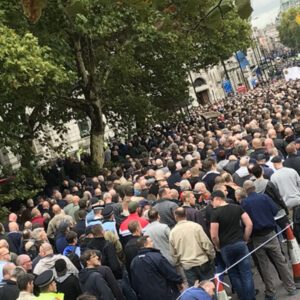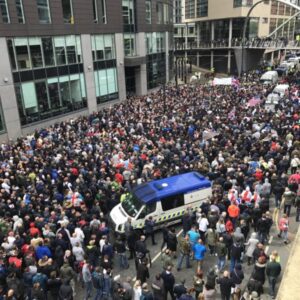MANCHESTER CITY CENTRE PICCADILLY GARDENS 5.00PM TOMORROW, 3 NOVEMBER Unite Against Fascism has issued a call for a protest against the fascist English Defence League founder’s book launch in Manchester tomorrow. It was been confirmed today that the event will take place in Manchester City Centre as a previous venue, the Bowlers in Trafford, […]
Anti fascist and community anger at fascist provocation in Whitechapel
Anti-fascists and members of Tower Hamlets’ diverse communities were angered by the appearance, locally, last Saturday, of a fascist gang, who have connections to the Football Lads Alliance, Unite Against Fascism wrote on Tuesday 24 October. Around 50 members of the notorious football hooligan gang the Chelsea Headhunters and a few other thugs were facilitated […]
Swedish anti-fascists report massive ant-fascist protest defeats the Nazis
The report below first appeared on the Unite Against Fascism website on 2 October. Big thanks to Asa and David for their contributions, below; hats off to Swedish anti fascists! Asa – Last Saturday was a brilliant victory for anti-fascists in Gothenburg, where over 10 000 people gathered and successfully stopped the Nazis from marching through […]
Football Lads Alliance: the far right march, plus six things you need to know
London witnessed the largest demonstration of the far right in generations on Saturday 7 October 2017. This was the second outing of the Football Lads Alliance.
Hate crime awareness event in Redbridge
Opposition grows to EDL founder’s book launch in Greater Manchester
MPs, MEPs, councillors and trade unionists support anti-fascist statement, Unite Against Fascism has announced. Opposition to a book launch being held, in Greater Manchester, by the founder of the far right English Defence League – ‘Tommy Robinson’ – is being organised by anti-fascist coalition Unite Against Fascism (UAF). Signatories to a statement organised by UAF, […]
Rare courage of a Soviet refusnik
Masha Slepak was, along with her husband, a central figure among the Moscow refuseniks of the 1970s, Colin Shindler wrote in The Jewish Chronicle on 15 September. Last Sunday Masha Slepak was buried in Jerusalem’s Har HaMenuchot cemetery alongside her husband, Vladimir. For virtually the entire duration of the Soviet Jewry campaign in the UK, […]
Four alleged members of Nazi, National Action arrested on terror charges
Searchlight welcomes Unite Against Fascism’s fast response to the news of the arrests of four serving soldiers under counter-terrorism legislation. Many of our readers who have followed closely our investigation of paramilitary training by the far right in the UK, with the assistance of Russian and Polish expert trainers, will be reminded by the UAF […]
Commemorating the ‘Battle of Lewisham’ 40 years on
August 13 marks the fortieth anniversary of what has become known and celebrated as The Battle of Lewisham. On that day in 1977, a fascist organisation, the National Front (NF) attempted to march through Lewisham and New Cross, in south London. It was a deeply provocative move in an area with a sizeable black population. […]
Rochdale unites against fascist EDL!
For the second time in a week, anti fascists protested at a fascist incursion into the town of Rochdale, last Saturday, Unite Against Fascism writes. Following a far from successful Britain First gathering, last Saturday, the English Defence League (EDL) held a march and rally, over this weekend. The fascists tried to exploit the issue […]
Antisemitic crime soars to highest ever level as police and prosecutors fail Jewish community
Geoffrey Alderman wrote on 20 July in the Jewish Weekly as follows: Last Sunday the Campaign Against Anti-Semitism released details of an investigation it had undertaken into the level and intensity of anti-Semitic hate crime in the UK in 2016. This audit was grounded in figures obtained from all UK police forces. The data makes […]
Can you stand with the NAFSAT community centre in Manchester, targeted by an arson attack?
TellMama writes as follows: On 15 July, the NASFAT family of mosques walked towards their national peace rally in Trafalgar Square. A deeply spiritual group who believe in community and family, this predominantly African group of social activists and organisers came to show their support against extremism and against groups like Boko Haram. One of […]
A massive win for all workers
The Supreme Court has ruled that employment tribunal fees are unlawful in a case brought by Unison. Reacting to the decision, Unison General Secretary Dave Prentis commented on 26 July: Today’s Supreme Court ruling is the most significant judicial intervention in the history of British employment law. This result is a massive win for our […]
Fascist EDL – not wanted in Rochdale, this Saturday, 29 July
Just seven days, after the fascist group Britain First held a hate gathering in Rochdale, another group of fascists, the EDL, will be making an incursion into the town. The EDL are, like Britain First, trying to create division by racialising the issue of crimes of sexual exploitation. Our thoughts must be with all those […]
Protest against fascist Britain First, Rochdale, 22 July
Pictured below, alongside Paul Golding (second from left), leader of the fascist group Britain First, is Jason Marriner (blue shirt), an ex Combat 18 fascist thug and convicted football hooligan. This is the sort of person that Britain First keep company with. One reason, among many, to demonstrate against Britain First next Saturday. Unite Against […]
German Nazis fail to save terrorist Horst Mahler from prison
Horst Mahler will be known to most long-time anti-fascists and readers of Searchlight as a man who has spent a lifetime as an active terrorist and the guru for thousands of hardline National Socialists and those who frequent up-and-coming extreme-right groups around the world. His father, a man of the cloth, was an underground opponent of the […]
Earthday 2017: Exploring the ‘Green’ Racism of Ann Coulter
This article has been contributed by Frank Houghton. Frank Houghton is a tenured Associate Professor and Chair of the Department of Public Health & Health Administration at Eastern Washington University. He has experience of working in Public Health and academia in the UK, Ireland, New Zealand, and the USA. By training he is a Public […]
International Nazi movement meets again in Norway
Erik Olson writes: The world’s two largest National Socialist publishing houses are engaged in an acrimonious dispute, Searchlight can reveal. Earlier this year we were able to supply the international media with details of yet another international Nazi gathering in Sweden, a regular feature since the creation of Generation Identity early in this decade. Exposure of […]
A second warning for antifascists: thousands on the streets of London as far right reorganises
This article is reproduced with permission of the authors, Martin Smith and Tash Shifrin and first appeared on the Dream Deferred website on 24 June 2017 here. It includes their eyewitness report from the FLA march. Up to 5,000 assorted Islamophobes, racists and fascists marched through central London today, mobilised by a rightwing coalition of […]
On the streets again: ‘Tommy Robinson’ and the EDL reloaded
This article is reproduced with permission of the authors, Martin Smith and Tash Shifrin and first appeared on the Dream Deferred website on 19 June 2017 here. This post was written shortly after the fascist march in Manchester, but we decided to hold back its publication in the wake of the tragic fire at Grenfell […]











